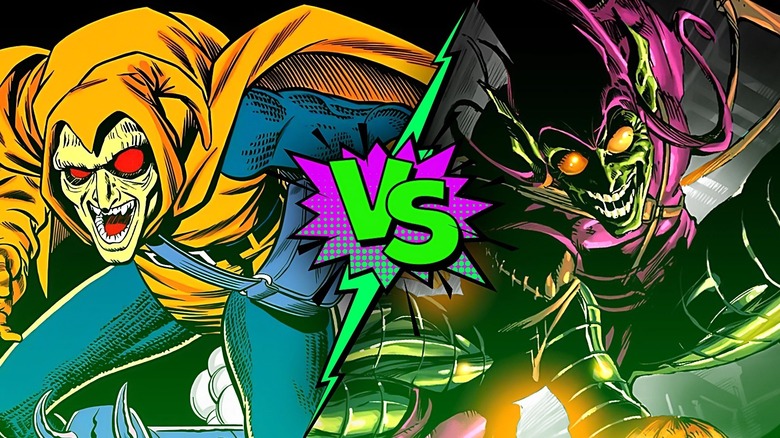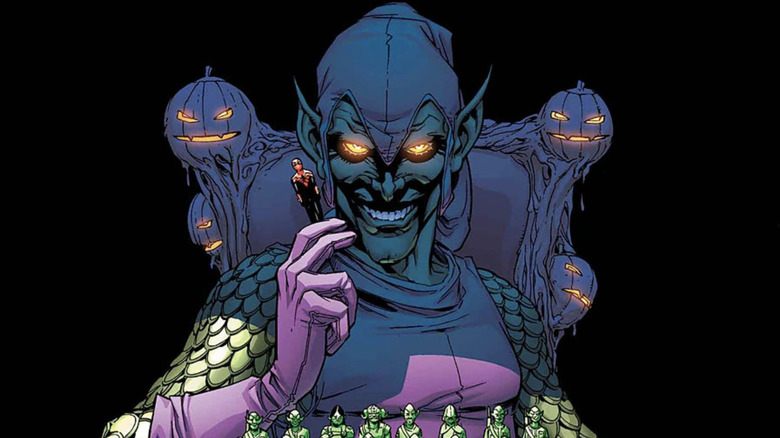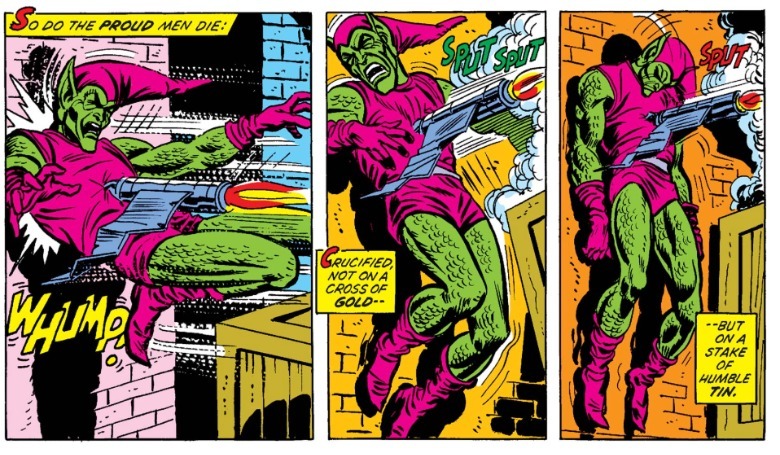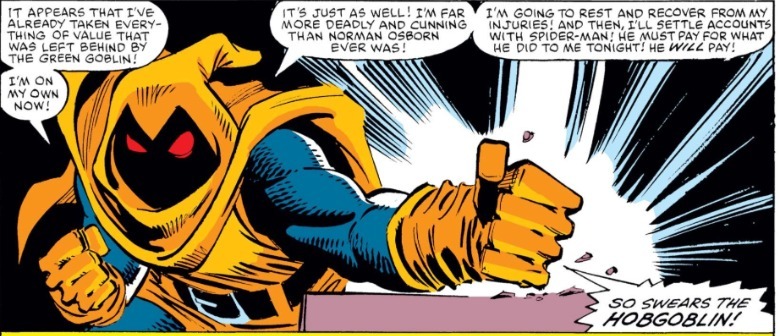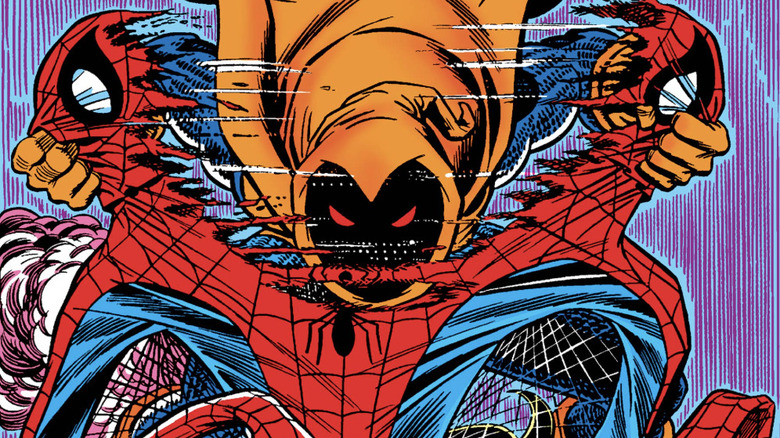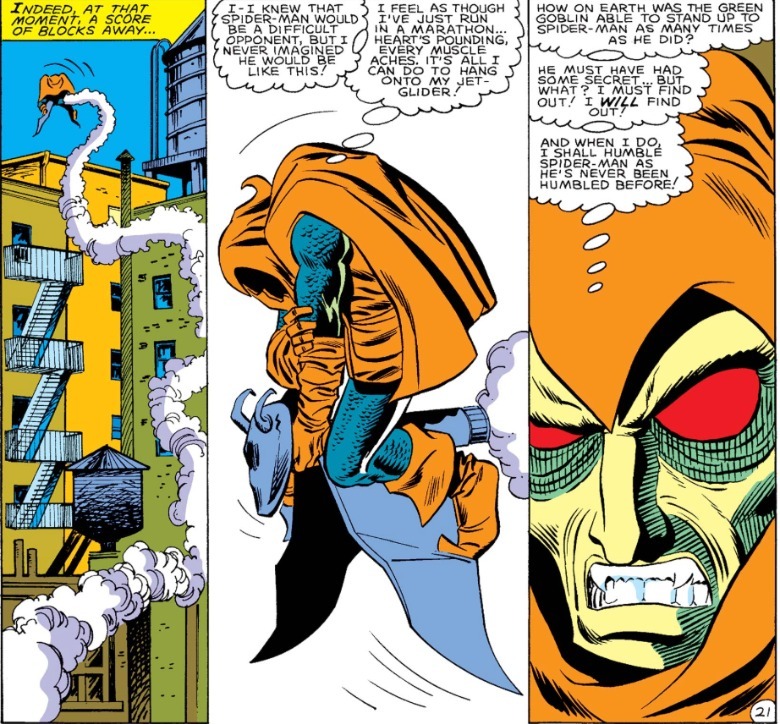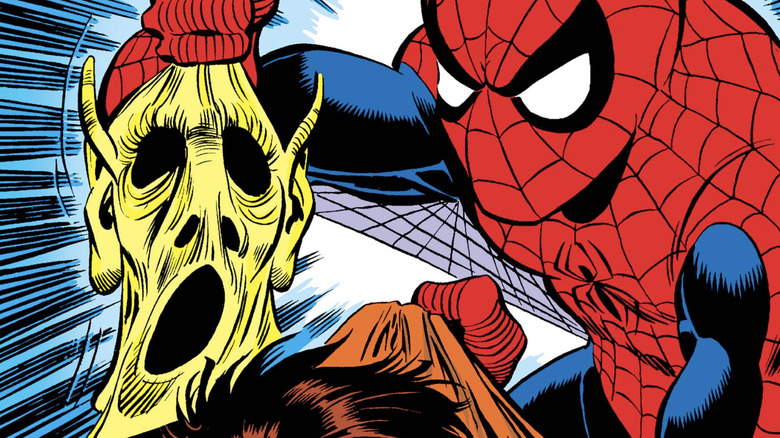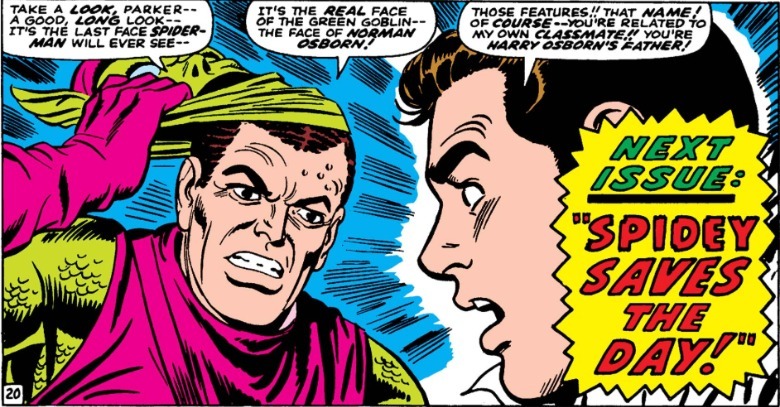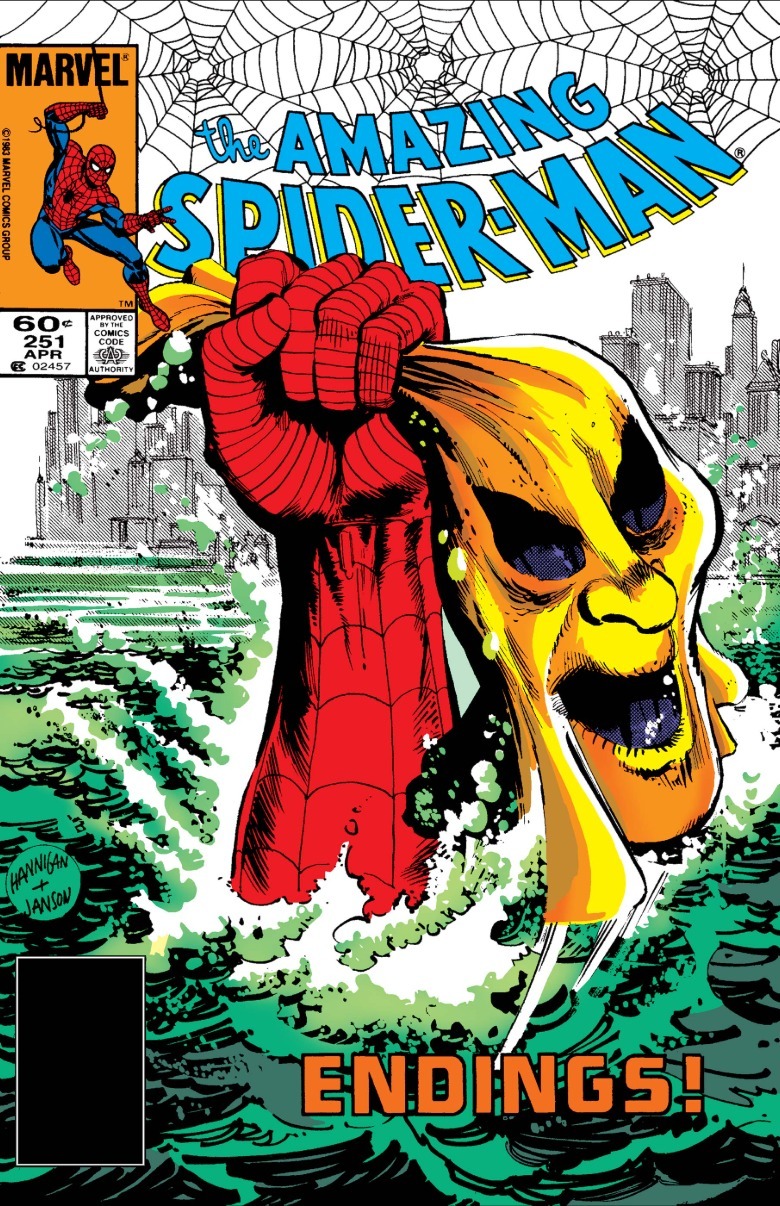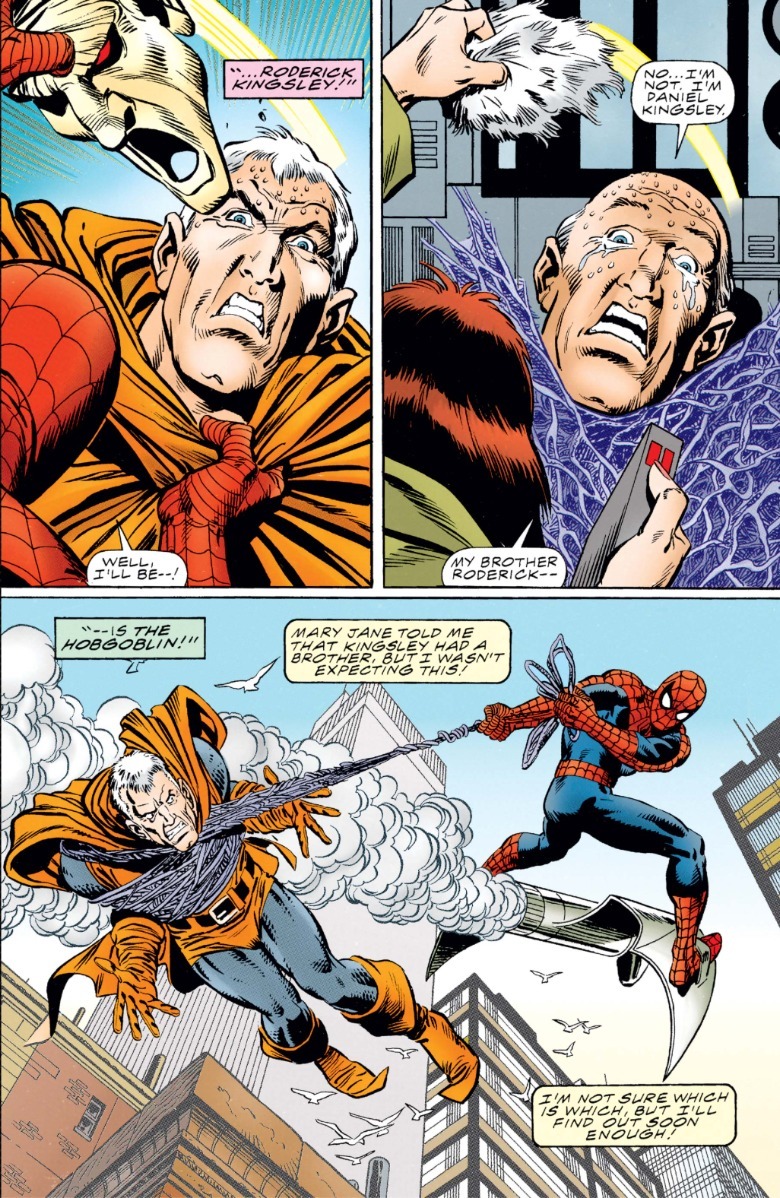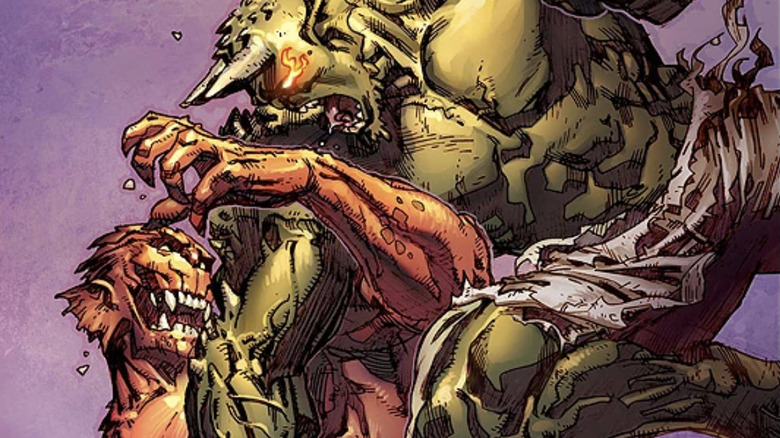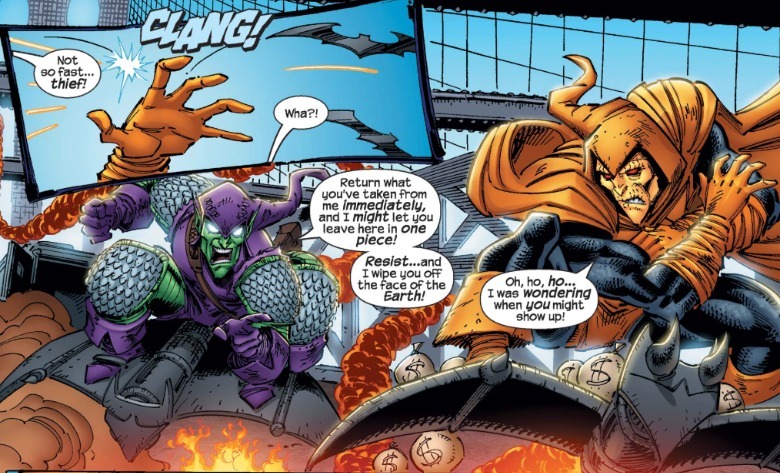Hobgoblin Vs Green Goblin: Who Is The Strongest Marvel Villain?
If you're a Spider-Man villain, odds are you're either themed after an animal or a Goblin. The original Green Goblin, Norman Osborn, is Spider-Man's most personal and deadly enemy, whether we're talking about the comics or Willem Dafoe's unforgettable Goblin in the "Spider-Man" movies.
As should be expected with any comic that's been running for 60 years, many "Spider-Man" writers have recycled classic ideas, which has led to many different Goblin successors. Some of them have worked, like Harry Osborn stepping into his dad's shoes after a falling out with his best pal Peter Parker.
But there's one Goblin villain distinct enough to be a separate character, even if he does still exist in the Green Goblin's shadow. That is the Hobgoblin, introduced in 1983's "Amazing Spider-Man" #238 by writer Roger Stern and artist John Romita Jr. Corporate titan Roderick Kingsley comes across one of the believed-dead Green Goblin's old hideouts, and uses the technology and information inside to become Spider-Man's horrifying new adversary, the Hobgoblin.
The Hobgoblin uses the same weapons as the original: A bat-themed jet glider, pumpkin-shaped bombs, bat razors, and gloves that shoot lasers from the fingertips. But he rocks a different (and frankly, cooler) costume, with a hooded orange cloak and yellow-hued, red-eyed mask. In his private life, Kingsley owned a fashion company (compared to Norman Osborn's science/tech empire), so of course he put his own spin on the costume.
Which Goblin reigns supreme? Green Goblin. The Hobgoblin is cool, but he can't beat the O.G. (original Green) in his impact on Spider-Man's life. Whenever they've fought, the Green Goblin usually comes out ahead, too. But that's not to diminish the Hobgoblin, who certainly has his moments.
The Hobgoblin is a pretender to the Green Goblin's throne
The Green Goblin comes out ahead simply because he came first. Debuting in "Amazing Spider-Man" #14 during the original Stan Lee/Steve Ditko years, he was one of Spidey's deadliest and most enigmatic foes from the beginning. Then, in Gerry Conway and Gil Kane's "Amazing Spider-Man" #121, he killed Peter's girlfriend Gwen Stacy, an unheard-of move in 1973 and one of the worst blows Spider-Man, or any Marvel superhero, had suffered to that point.
The Green Goblin's murder of Gwen happened because he discovered Spider-Man's secret identity, something the Hobgoblin never accomplished. It was also a crime so great that he had to die, and did, in the following issue, #122.
Osborn stayed dead for 23 years until being retconned as having survived in 1996 (which I'm still not sure was the best move), yet his absence was a testament to his power and the hurt he'd caused Spider-Man. Even in death, Norman poisoned Peter's friendship with Harry, who was convinced Spider-Man murdered his father and then snapped when he realized Peter and Spider-Man were one and the same. Harry went down a path that ended in his death in "Spectacular Spider-Man" #200, yet another mortal blow to Peter's heart.
The Hobgoblin will always be second best; he never accomplished anything so personal as the Green Goblin has, nor has he been as dogged an enemy to Spider-Man ... except in the 1994 "Spider-Man" cartoon.
That show features a complete reversal of the mythology: The Hobgoblin came first, debuting in season 1 while Norman Osborn only became the Green Goblin in season 3. This wasn't due to creative reasons, though; as showrunner John Semper confirmed, the previous (fired) series writer had wanted to use the Hobgoblin, which meant producer Avi Arad put in an order for Hobgoblin action figures to ToyBiz, so the show had to feature the villain to advertise them. (Both Osborn and Kingsley would probably appreciate the power of capitalism on display there.)
In "Amazing Spider-Man" #261, at the height of his enmity with Spider-Man, the Hobgoblin boasts he's the superior Goblin, but it comes off as empty self-aggrandizement.
He's neither as strong or as vicious as Norman Osborn was — which, in one case only, is an advantage.
The Green Goblin is insane, The Hobgoblin is not
The Hobgoblin first faces Spider-Man in his second appearance, in "The Amazing Spider-Man" #239 — and he barely escapes since, glider and pumpkin bombs aside, he's still a normal man. So, the Hobgoblin's following appearances focus on him trying to recreate the chemical that gave the Green Goblin his strength.
In "Amazing Spider-Man" #244, the Hobgoblin tests the formula on a low level thug, "Lefty" Donovan, then dresses his guinea pig up as the Hobgoblin to see how he fares against Spider-Man. In "Spectacular Spider-Man" #85, the Hobgoblin finally succeeds in recreating Osborn's formula and bathes in it, becoming strong enough to properly battle Spider-Man. There's one key difference, though: Hobgoblin modifies the formula so that the exposure doesn't drive him insane like it did Norman Osborn.
Speaking to "Back Issue!" Magazine, Stern said that the villain's sanity was an essential part of his conception and the threat he posed: "Unlike Norman, who was as crazy as a soup sandwich, this guy would be frighteningly sane. A megalomaniac, sure, but he knows exactly what he's doing. He doesn't do stupid things. He does coldly rational things, which makes him even scarier."
Whereas the Green Goblin enjoyed spreading mischief like a Puck-ish sprite, the Hobgoblin is more of a calculating mastermind. He rarely laughs, and there's only cold, cruel glee in the Hobgoblin's eyes and smile, never mania like there is in the Green Goblin's. In Stern's "Spider-Man: The Hobgoblin Lives," the villain declares, "The Green Goblin was the mad one, there is no madness in the method of the Hobgoblin!" And when the Hobgoblin comes face-to-face with the Green Goblin in "Spectacular Spider-Man" #260, he's unnerved by his predecessor's madness.
Even in "Spider-Man: The Animated Series," where the Hobgoblin was voiced by Mark Hamill with a raspier take on his famous Joker performance, the villain was always after money first and foremost. For this character, getting his hands on some green Benjamins is the most rational reason to be a criminal.
Norman Osborn is the Green Goblin, but who is the real Hobgoblin?
The Green Goblin was introduced in "Amazing Spider-Man" #14, then his identity was kept secret for 25 issues until the final panel of "Amazing Spider-Man" #39, when he unmasked himself as Norman Osborn.
The truth about the Hobgoblin's identity would not be nearly as straightforward. Accepted Marvel Comics canon says the one-and-true Hobgoblin is Roderick Kingsley, but it was a long, bumpy, 14-year journey to get there — as covered by Glenn Greenberg at "Back Issue!" magazine. In "When Hobby Met Spidey," Greenberg interviews various '80s Spider-Man writers/editors to decipher how the Hobgoblin's origin became such a tangled web.
Let's set the scene: It's 1983, and Roger Stern is writing "The Amazing Spider-Man." He notices that readers writing in to the letters page want the Green Goblin back, which inspires him to create a successor villain: The Hobgoblin, designed by John Romita Jr. To capture the old Lee/Ditko magic, the Hobgoblin's true identity will also be a mystery. (Tom DeFalco, who was Spider-Man editor when Stern was writing, claimed to "Back Issue!" that the mystery was his idea.)
From almost the beginning, Stern intended the Hobgoblin to be Roderick Kingsley; Stern had introduced Kingsley himself in an earlier story. Per his remarks to "Back Issue!", Stern plotted "Amazing Spider-Man" #238 without knowing who the Hobgoblin is, but once he started writing the villain's dialogue, he knew it had to be Kingsley. He set up a red herring in "Amazing Spider-Man" #249, when the Hobgoblin tries to blackmail NYC's elite and Kingsley is among the victims. To Stern, this was Daniel Kingsley, Roderick's weak-willed younger brother, who he used as a body double.
Per DeFalco's recollection, Stern kept the truth so close to his chest that he didn't even tell him, his editor: "I told Roger, 'I'm going to keep a list of suspects and I'm going to cross off guys as their times come, and when it comes time to reveal, you'll tell me who you think it is, and if I agree, that's who it'll be. And if I don't agree — well, I'm the editor!'"
Stern intended the Hobgoblin mystery to go on one issue longer than the Green Goblin's (meaning it would've wrapped in "Amazing Spider-Man" #264 or so). Unfortunately, Stern left "Amazing Spider-Man" due to a clash of personalities with new editor Danny Fingeroth. Stern's final issue, "Amazing Spider-Man" #251, teases on its cover that the Hobgoblin's identity will be revealed, but the issue itself doesn't follow through.
After Stern left, DeFalco went from editor to writer of "The Amazing Spider-Man." He finally got the truth about the Hobgoblin from the departing Stern, but the problem was DeFalco wasn't convinced. In particular, he thought the proposed twin trick with the Kingsley brothers would be cheap storytelling. So, he went back to his suspect list and concluded the Hobgoblin should be someone else: Richard Fisk, son of the Kingpin. As a mafia prince, Fisk Jr. of course would have the underworld connections and ambition to pass as the Hobgoblin.
So, DeFalco intended to reveal Richard Fisk as the Hobgoblin and Roderick Kingsley as Hobby's partner-in-crime, the Rose. Even Stern agreed this would've been a "fine" answer. But it didn't happen; ultimately, the exact inverse of DeFalco's resolution played out. Richard Fisk was the Rose, and Kingsley would ultimately be unmasked as the Hobgoblin much later.
In the meantime, though, the Hobgoblin was pinned to Ned Leeds. Marvel movie fans might be thinking, Wait, Spidey's nerdy best friend Ned (played by Jacob Batalon) from the "Homecoming" trilogy? Well, not exactly. See, the Marvel Cinematic Universe's version of Ned Leeds is more like an adaptation of Ganke Lee, Miles Morales' Asian-American best friend. Comic Ned Leeds was an adult Daily Bugle reporter and future husband of Betty Brant. (His name, "Leeds," even feels like a journalism pun.) Ned was one of the earliest Spider-Man supporting characters, debuting in "Amazing Spider-Man" #18, and mostly friendly with Peter. So, why make him the Hobgoblin?
Is Ned Leeds the Hobgoblin?
In 1985, James Owsley (now known as Christopher Priest) took over as Spider-Man editor. At a Spider-Man office "creative conference" (attendees included Owsley, DeFalco, and "Peter Parker, The Spectacular Spider-Man" writer Peter David), it was apparently decided that Ned Leeds would be the Hobgoblin. DeFalco claimed to "Back Issue!" that he only said this in response to pressure from Owsley and that "in reality, Ned Leeds was never seriously considered as the Hobgoblin." Peter David, though, claimed that the group settled on Leeds together.
For what it's worth, DeFalco and artist Ron Frenz's last string of "Amazing Spider-Man" issues contain lots of foreshadowing that Ned Leeds is the Hobgoblin. (DeFalco claimed that most of his scenes setting up Richard Fisk were cut by editorial to clear up page space.) For instance, in "Amazing Spider-Man" #275, Ned disappears off-panel and then the scene cuts to the Hobgoblin emerging.
There's also recurring details like Ned's wife Betty having trouble contacting him; when he blames the difficulty on him doing some undercover reporting, Betty repeats that to Daily Bugle editor Robbie Robertson, who has no clue what she's talking about. In "Amazing Spider-Man" #276, the Hobgoblin kidnaps Flash Thompson and frames him as the Hobgoblin. Flash had been having an affair with Betty, giving Ned plenty of reason to want to hurt him.
Then, yet another problem struck. Ned Leeds was killed off in 1987's "Spider-Man vs Wolverine" #1, a story completely unrelated to the Hobgoblin, and shortly after, Owsley fired DeFalco from "Amazing Spider-Man." (DeFalco said to "Back Issue!" that he believes Owsley was trying to cut off any chance that DeFalco would explode on him for keeping him out of the loop.)
Owsley recruited Peter David for the big reveal issue of the Hobgoblin's true identity in "Amazing Spider-Man" #289, but David read past issues and concluded the Hobgoblin couldn't be anyone but Ned Leeds. So, #289 retconned the circumstances of Ned's death in "Spider-Man Vs Wolverine" #1; Ned was the Hobgoblin, and was assassinated on the orders of Jack O'Lantern/Jason Macendale, another Halloween-themed criminal with a grudge against the Hobgoblin. As a last insult, Macendale stole the Hobgoblin identity for himself.
David recalled writing this anti-climax to "Back Issue!":
"My argument was, 'Once we kill off Ned, he'll go from being the lead suspect to the last guy you would think of. Because who would be stupid enough to do a story in which we reveal the identity of the Hobgoblin after the guy is dead? And that we never have the big climactic confrontation and unmasking that everyone is expecting and which has been done a hundred times? This has never been done before! Fans are going to go so bats**t over this that it'll never be done again, because it is quite conceivably the dumbest resolution that we could possibly have!' Owsley said, 'I love it!' And I was brought in to write the resolution issue."
So, for 10 years, accepted "Spider-Man" canon was that Ned Leeds had been the Hobgoblin — until 1997, when Stern got to write "The Hobgoblin Lives" and tied this loose thread back to the real Hobgoblin all along, Roderick Kingsley.
The innocent Ned Leeds, Stern revealed, had been investigating the Hobgoblin, only to be abducted and brainwashed by him. Kingsley used Ned (who, after the brainwashing, believed he was the Hobgoblin) as a patsy, and set him up to be killed so he could escape his criminal life unscathed.
Stern, who never bought Ned as the Hobgoblin, even used his own rationale as Peter Parker's "eureka!" realization. The Hobgoblin had super-strength; if Ned had that power, he should've been able to fight off his assassins, but he wasn't. "Hobgoblin Lives" is obviously Stern making the best of a mess, and him simply getting to write his whole storyline back in "The Amazing Spider-Man" would've been preferable. Still, it's convincing enough because the Hobgoblin was previously established to use stand-ins (i.e. Lefty Donovan and Flash Thompson). Though worthy of a soap opera, Ned being framed and dressed-up doesn't come out of nowhere.
Is there a Hobgoblin suit in MCU Ned Leeds' future? Personally, he doesn't strike me as true super-villain material — just like the comic Ned Leeds ultimately wasn't.
The Green Goblin is the ultimate Spider-Man villain
Whenever the Green Goblin and Hobgoblin fight, the former usually comes out on top. In "Spectacular Spider-Man" #259-261 (the first time Osborn and Kingsley meet), the Green Goblin outwits the Hobgoblin, buying his companies and assets out from under him and completely upending Kingsley's blackmail bluff to expose Osborn's secret identity.
In "Spider-Man: The Animated Series," the Hobgoblin may have come first, but he was still inferior. In this series, only the Green Goblin had super-strength, so once he decided Manhattan was only big enough for one goblin, the Hobgoblin was totally out of his league.
In "Marvel Adventures Spider-Man" (a more kid and new reader-friendly retelling of classic Marvel Comics), the two Goblins exist simultaneously. The Hobgoblin is a simple criminal who stumbles across the Green Goblin's base and robs it. His true name is so unimportant, the issue never even reveals it. Still, once the Green Goblin discovers the burglary, he takes it as a massive insult. Even with fire in his eyes and soul, he outwits and defeats the braggadocious Hobgoblin.
Finally, Brian Michael Bendis' "Ultimate Spider-Man" reimagined Spidey and his mythos, down to a different take on the Goblin. Instead of a costume, Norman Osborn physically transformed into a green-skinned, fire-ball throwing monster, Hulk-style. The Hobgoblin, in turn, is simply Harry Osborn exposed to the same formula as his father, but with orange skin instead of green. In "Ultimate Spider-Man" #112-117 (by Bendis and artist Stuart Immonen), father and son clash; the Green Goblin overpowers and kills the Hobgoblin, only to be horrified once he comes to as Norman.
Of course, Norman blames only Spider-Man for Harry's death, not himself. The Green Goblin's deluded grudge against Peter Parker dwarfs the strength of anything driving the Hobgoblin.
